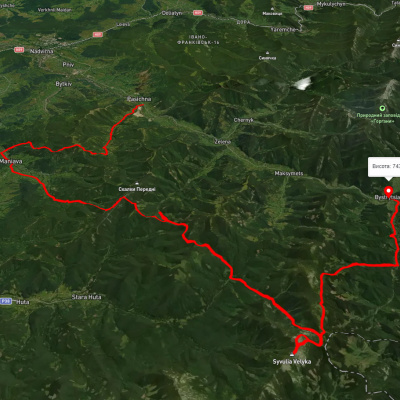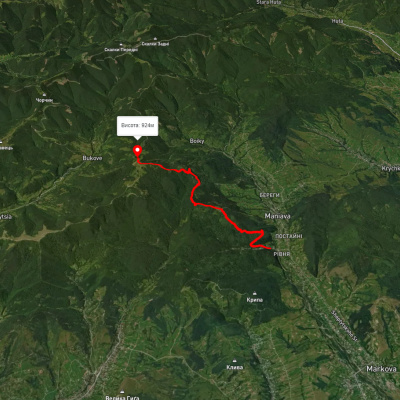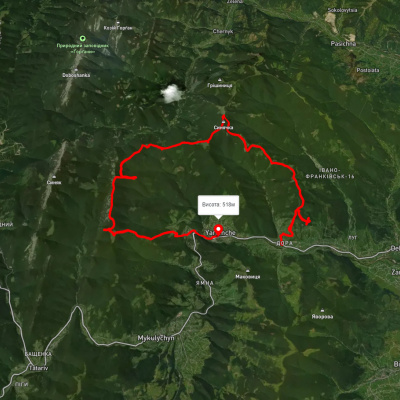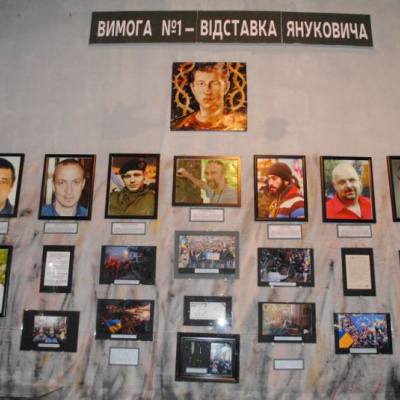Museum of the Heavenly Hundred, Ivano-Frankivsk
The Museum of the Heavenly Hundred in Ivano-Frankivsk was opened on September 11, 2015. Almost a year after the events on the Maidan ended. Nothing here is still called an artifact or an exhibit. Only the memory of the Heroes who died during the Revolution of Dignity. And there are more than 800 such "things of memory" here. Among them are personal belongings of the Maidan participants, their portraits, as well as artworks and installations that visually bring people back to those events. Their author is Roman Bonchuk, an artist from Ivano-Frankivsk, who came up with the idea of creating this Museum of the Heavenly Hundred.
At the time, the artist painted everything: how the Maidan began, how the events unfolded, portraits of individuals, and the fallen heroes. He kept some of the paintings, while others he simply gave to people.
The icon of the Heavenly Hundred Heroes and the Maidan diorama are in the main part of the Museum. The diorama depicts 92 days of the Revolution of Dignity. Next to it is an installation created by people who cared.
The doors of the Museum were always open. People brought here things of Maidan participants, their poems, memories... Every pavement here was loaded with text. A movement began that could not be controlled or predicted. It was as if the museum began to live on its own, and this life has not stopped here to this day," says Roman Bonchuk.
The tour is based on the stories of people who were on the Maidan. There are items and a portrait of Roman Huryk, a 19-year-old student from Ivano-Frankivsk. Among them is Roman's backpack, which he used to go to the Maidan.
Children often look for grenades and weapons used to defend themselves during the Revolution of Dignity in the Heavenly Hundred Museum. A makeshift chapel was created in the Museum, and photos of all the priests who were on the Maidan and supported people, blessed them with prayers, performed funeral services for the dead, and constantly tried to stop the offensive of the security forces were placed on the "prayer wall."
Today, the Museum has portraits of 108 Heroes of the Heavenly Hundred. It is noted here that the youngest, Nazar Voitovych from Ternopil region, was only 17 years old at the time, and the oldest, Ivan Nakonechnyi from Kyiv, was about to turn 83. The Museum claims that the history of the Maidan is still being researched by volunteers, and therefore Ukrainians should be prepared for new pages in the history of the Revolution of Dignity.
All the portraits of the Heroes are placed in the initial sector of the Museum. There are construction helmets, protective masks, wooden shields, and drainage pipes that people stood with to die. An installation against the backdrop of St. Michael's Cathedral, where activist medics worked, eloquently tells how Maidan participants died and how their lives were saved. Medical instruments are displayed next to a mannequin of a wounded man. The medics also brought them here from the Maidan.
Volunteers from the Maltese Service helped to set up the Maidan field kitchen. Most of them came from Ivano-Frankivsk. After the Maidan, it was they who handed over to the Museum the ax with which Serhiy Nihoyan worked at the woodshed.
To recreate the full range of emotions of the Maidan period, the Heavenly Hundred Museum also exhibits an old piano. This musical instrument did not take part in the Revolution of Dignity, but it reminds us of its counterpart.
The Museum of the Heavenly Hundred continues to collect eyewitnesses' belongings and create exhibitions about Ukrainians who went through not only the Maidan but also the Ukrainian-Russian war.
The museum is preparing an exhibition in memory of Yaroslav Chomko, which will open on February 20. During the Revolution of Dignity, Yaroslav provided medical care at the October Palace, where he was called "an angel in a white coat." When the events in the East began, Yaroslav volunteered to serve in the Pirogov Company of the National Guard.
Meanwhile, the author of the Heavenly Hundred Museum idea, Roman Bonchuk, is finalizing another project, The Defense of Donetsk Airport. He says that the heroic spirit of Ukrainians deserves to be shown in all European cities.
The museum is visited with interest by adults and children. Their mentors, the guide says, often admit that the Heavenly Hundred Museum changes their worldview because they have seen and heard things that are not yet written in textbooks.
The Museum of the Heavenly Hundred is an unusual place. It differs from all other museums. It has different standards and ideas. The expositions dedicated to the Heavenly Hundred are located on a large area, namely five hundred square meters. This area is conditionally divided into several zones. In particular, the spiritual Maidan, the artistic zone, and the self-defense zone. The museum's exposition includes an installation of tires and stone, self-defense weapons, shields, barrels, helmets, and spent shell casings.
At the entrance to the museum there are guardian angels who protect the souls of the Heavenly Hundred. You can also recall and examine portraits of all 107 fallen Maidan activists.
The museum is open every day except Sunday. On weekdays - 10.00-18.00, on Saturday - 11.00-17.00. Admission to the museum is free, but you can make a charitable contribution if you wish.
Accommodation around Museum of the Heavenly Hundred, Ivano-Frankivsk:
Nearby hiking trails near Museum of the Heavenly Hundred, Ivano-Frankivsk:
Які маршрути проходять повз Museum of the Heavenly Hundred, Ivano-Frankivsk?
Пропонуємо пройти такі туристичні (пішохідні) маршрути через/біля Museum of the Heavenly Hundred, Ivano-Frankivsk: с. Пасічна, через с. Манява, Манявський вдсп., г. Велика Сивуля до с. Бистриця, с. Манява - пол. Монастирецька, с. Дора, через г. Синячка, пер. Пересліп, пол. Туршугувата, хр. Явірник до м. Яремче, с. Дора, через г. Синячка, пер. Пересліп до м. Яремче, с. Дора, через г. Синячка, пол. Чорногориця до м. Яремче, с. Дора, через г. Синячка, хр. Чорногориця до м. Яремче










